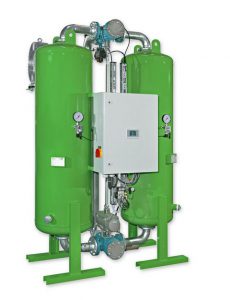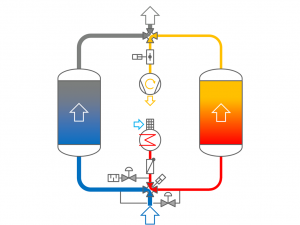Adsorption dryers of the DTS..V series are designed for drying compressed air and nitrogen to pressure dew points of -25°C to -70°C (depending on the design) at operating pressures of 4 bar to 11 bar (up to 63 bar on request).
Function
Adsorption dryers consist of two pressure vessels, which are both filled with desiccant and are alternately operated via switch-over. The compressed air to be dried flows through a vessel where the moisture is thoroughly removed by the desiccant (adsorption). At the same time, the moisture stored in the desiccant in the second vessel is removed (regeneration). If the desiccant in the vessel in which adsorption takes place is saturated with moisture then the vessels are switched and the process begins again. One complete run of adsorption and regeneration in a vessel is called a cycle, and the time required is the cycle time.
For DTS series dryers, the change interval between adsorption and regeneration is 6 hours at nominal conditions. The cycle time is therefore 12 hours.
The regeneration takes place with ambient air, which is drawn in by a vacuum pump, warmed in an electric heater and fed through the desiccant (heating). The hot air removes the moisture from the desiccant and releases it to the environment at the outlet (heat regeneration).
Cooling is carried out in a similar manner with the electric heater switched off – without the need for purge air (fast cooling).
Further energy savings can be made through integration of the customer’s alternative energy sources (e.g. steam or hot water) and/or thermal insulation.
Features
The dryers are operated with a 2-layer desiccant bed, consisting of 30% water resistant silica gel WS and 70% high-grade drying silica gel N. The desiccant has a high drying capacity for moisture and a long service life of several years. This ensures permanently low and stable pressure dew points.
Working principle

